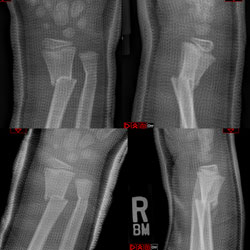Displaced Distal Radius Fractures in Children: To Reduce or Not to Reduce? To Pin or Not to Pin? Current Concept Review
Main Article Content
Abstract
Displaced distal radius fractures in children are routinely treated with closed reduction under sedation, which adds risk and cost. Many metaphyseal fractures, especially in young children (under age 10), may have the capacity to remodel without reduction. Which fractures need treatment, at any given age? What other factors should we consider? Also, if we decide to reduce these fractures, do we need to pin them? This review summarizes the available literature and hopes to guide clinicians in treatment of children with distal radius fractures presenting to their practice.
KEY POINTS:
- Displaced distal radius fractures often undergo sedated reduction in children.
- Remodeling potential of the metaphyseal distal radius is significant in both the sagittal and coronal planes.
- Complete remodeling without sequelae of 100% displaced and shortened distal radius fractures has been reported in children under age 10.
- Pinning eliminates risk of loss of reduction but may lead to unnecessary surgery in about 60% of cases.
- Large, prospective studies are ongoing or planned for the near future.
Article Details
How to Cite
Truong, W., Howard, A., & Georgiadis, A. (2020). Displaced Distal Radius Fractures in Children: To Reduce or Not to Reduce? To Pin or Not to Pin? Current Concept Review. Journal of the Pediatric Orthopaedic Society of North America, 2(2). https://doi.org/10.55275/JPOSNA-2020-77
Section
Trauma

